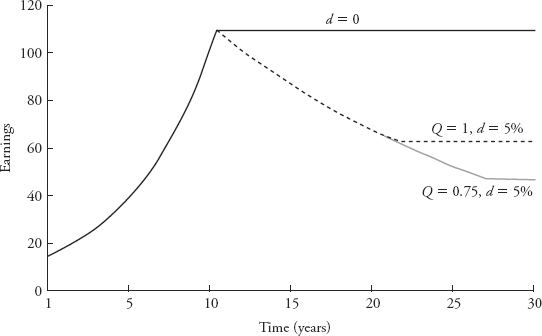BASIC TWO-PHASE GROWTH MODEL
Now turn to a basic growth model that approximates many formulations encountered in practice. The model consists of two phases: The first is H years of earnings growth at an annual rate g, and the second is the full payout of the earnings level reached at the end of the first phase. The ultimate in simplicity is obtained by treating the first phase as requiring total reinvestment of all earnings (i.e., there are no cash payouts until the second phase). The upper curve in Figure 9.4 illustrates the earnings pattern associated with such a two-phase model with earnings growth of 22 percent over a 10-year period.
FIGURE 9.4 Earnings in a Two-Phase Growth Model

The first step is to determine the P/E for the standard case in which the terminal phase consists simply of a constant earnings stream. This ratio can be easily found:

Thus,
![]()
This two-phase model is generally intended to reflect an initial span of growth and prosperity followed by a second-phase regression to a competitive equilibrium. The two lower curves in Figure 9.4 illustrate the earnings associated with applying the harsher (Q, d) version of competitive equilibrium to this second phase. The first ...
Get Valuation Techniques: Discounted Cash Flow, Earnings Quality, Measures of Value Added, and Real Options now with the O’Reilly learning platform.
O’Reilly members experience books, live events, courses curated by job role, and more from O’Reilly and nearly 200 top publishers.

